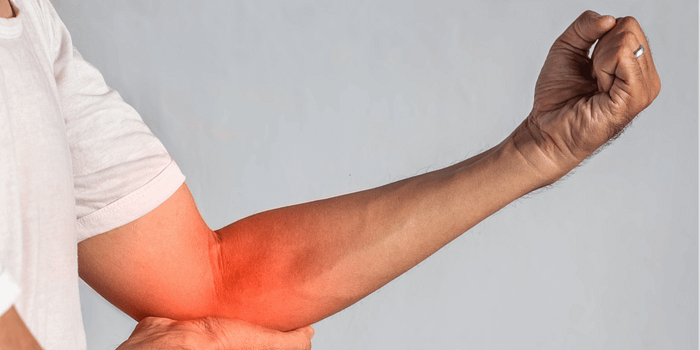Ultrasound-Guided Cortisone and Hyaluronic Acid Injections for Golfer’s Elbow
Golfer’s elbow, or medial epicondylitis, is a condition characterised by pain and inflammation in the tendons that connect the forearm to the elbow. While it’s commonly associated with repetitive wrist and forearm motions in sports like golf, it can affect anyone engaging in repetitive tasks.
At Alton Pain Clinic, we offer advanced treatment options, including ultrasound-guided cortisone and hyaluronic acid injections, tailored to alleviate the discomfort of golfer’s elbow and support recovery. This blog provides an in-depth exploration of golfer’s elbow, its anatomy, pathology, and the role of cortisone and hyaluronic acid injections in managing this condition.

Understanding Golfer’s Elbow
Definition
Golfer’s elbow is a type of tendinopathy affecting the medial epicondyle of the elbow. It is caused by overuse or repetitive strain on the flexor tendons of the forearm, leading to pain, inflammation, and reduced strength.
Common Terminology
- Also referred to as medial epicondylitis.
- It contrasts with tennis elbow, which affects the lateral epicondyle.
Anatomy of the Elbow
Key Structures
- Bones
- Humerus: The upper arm bone, with the medial epicondyle forming part of the elbow joint.
- Ulna and Radius: Forearm bones involved in wrist and elbow movement.
2. Tendons and Muscles
- Flexor Tendons: Attach forearm muscles to the medial epicondyle, facilitating wrist and finger flexion.
- Pronator Teres Muscle: Contributes to forearm rotation and wrist stability.
3. Nerves
- Ulnar Nerve: Passes near the medial epicondyle and may become irritated in severe cases of golfer’s elbow.
4. Ligaments
- Provide stability to the elbow joint during movement.
Pathology of Golfer’s Elbow
Mechanism
Golfer’s elbow results from repetitive microtrauma to the flexor tendons at their origin on the medial epicondyle, leading to:
- Tendon Overload: Microtears in the tendon fibres due to overuse.
- Inflammation: Acute cases involve swelling and pain.
- Degeneration: Chronic cases can lead to tendinosis, characterised by collagen breakdown and scar tissue formation.
Causes
- Repetitive wrist or forearm movements, such as swinging a golf club or manual labour tasks.
- Poor technique in sports or activities that strain the flexor tendons.
- Weak forearm muscles, contributing to increased strain on the tendons.
Risk Factors
- Occupational Strain: Common in professions involving repetitive arm movements, such as carpentry or typing.
- Age: More prevalent in individuals between 40 and 60 years.
- Sports Participation: Particularly in golfers, throwers, and racquet sports players.
Symptoms of Golfer’s Elbow
- Pain and tenderness on the inner side of the elbow, often radiating down the forearm.
- Stiffness in the elbow, especially in the morning.
- Weakness in the hand and wrist, making gripping objects challenging.
- Tingling or numbness in the fingers, particularly the ring and little fingers.
Diagnosis of Golfer’s Elbow
Clinical Examination
- Inspection: Assessment for swelling, redness, or deformities around the elbow.
- Palpation: Identifying tenderness at the medial epicondyle.
- Range of Motion Tests: Evaluating elbow flexibility and wrist function.
Special Tests
- Resisted Wrist Flexion Test: Pain with resistance against wrist flexion indicates golfer’s elbow.
- Passive Stretch Test: Stretching the forearm flexors reproduces symptoms.
Imaging
- Ultrasound: Identifies tendon tears, inflammation, or calcification.
- MRI: Useful for assessing severe cases and ruling out other conditions.
Management of Golfer’s Elbow
Conservative Treatments
- Activity Modification
- Avoiding activities that aggravate symptoms.
2. Physical Therapy
- Strengthening and stretching exercises for the forearm muscles.
- Techniques to improve wrist and elbow biomechanics.
3. Medications
- Nonsteroidal anti-inflammatory drugs (NSAIDs) for pain relief.
Role of Ultrasound-Guided Injections
When conservative treatments fail to provide relief, ultrasound-guided injections are a minimally invasive option for managing golfer’s elbow.
Types of Injections
- Cortisone Injections
- Reduces inflammation and provides short-term pain relief.
2. Hyaluronic Acid Injections
- Enhances tendon lubrication and promotes healing by reducing friction.
How Cortisone and Hyaluronic Acid Help with Golfer’s Elbow
Cortisone Injections
Cortisone is a corticosteroid with potent anti-inflammatory properties.
Mechanism of Action
- Inflammation Suppression
- Inhibits the production of inflammatory mediators, such as prostaglandins and cytokines.
- Reduces swelling and pain at the injection site.
2. Pain Relief
- Cortisone decreases nerve sensitivity in inflamed tissues.
3. Facilitating Rehabilitation
- Alleviates pain, allowing patients to engage more effectively in physiotherapy.
Hyaluronic Acid Injections
Hyaluronic acid is a naturally occurring substance in the body that contributes to joint and tendon lubrication.
Mechanism of Action
- Lubrication
- Reduces friction between the tendon and surrounding structures, minimising irritation.
2. Tissue Healing
- Enhances the repair process by providing a scaffold for cell growth.
3. Pain Reduction
- Improves biomechanical function, relieving strain on the affected tendon.
Advantages of Ultrasound Guidance
- Precision: Ensures accurate delivery of the injection to the affected area.
- Safety: Minimises risks by avoiding nearby structures like nerves and blood vessels.
- Real-Time Visualisation: Enables the clinician to adjust the injection technique as needed.
Why Choose Alton Pain Clinic?
At Alton Pain Clinic, we are committed to providing patient-centred care using the latest techniques and technologies.
What Sets Us Apart
- Expertise: Our clinicians are highly skilled in managing tendon injuries.
- State-of-the-Art Technology: Advanced ultrasound equipment ensures precise treatment.
- Tailored Care: Individualised treatment plans based on each patient’s unique needs.
- Comprehensive Approach: We combine injections with physiotherapy and lifestyle advice for optimal recovery.
Post-Injection Care
- Rest the elbow for 24–48 hours after the procedure.
- Gradually resume activities, avoiding repetitive motions initially.
- Follow-up with physical therapy to strengthen the forearm muscles and prevent recurrence.
Conclusion
Golfer’s elbow can significantly impact your ability to perform daily tasks and enjoy recreational activities. With ultrasound-guided cortisone and hyaluronic acid injections, patients can experience relief from pain and support the recovery process. At Alton Pain Clinic, we are dedicated to offering advanced, minimally invasive treatments tailored to your specific needs.
For more information or to book an appointment, contact Alton Pain Clinic today. Let us help you get back to doing what you love.

Comments
Post a Comment